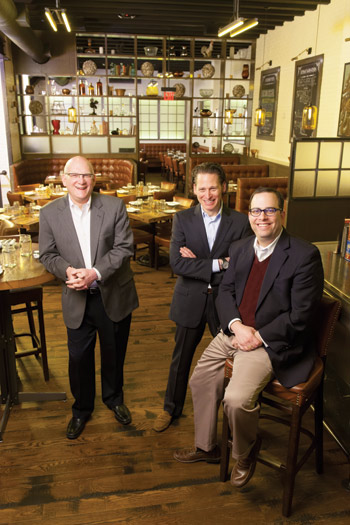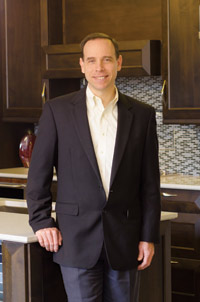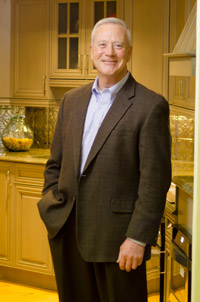With 1,500-plus employees working in 20 locations, Wasserstrom is a large and diverse organization that continues to maintain a small company feel. Wasserstrom does this by balancing the strengths of its past with an understanding that the company needs to remain flexible in order to adapt to changing market conditions.
 Leading the charge are the third and fourth generations of Wasserstroms — Brad, Bruce and Eric. All share the title of president and all approach their areas of responsibility with a people-first mentality. FE&S asked Brad, Bruce and Eric to share their thoughts about how the company continues to evolve and to look ahead.
Leading the charge are the third and fourth generations of Wasserstroms — Brad, Bruce and Eric. All share the title of president and all approach their areas of responsibility with a people-first mentality. FE&S asked Brad, Bruce and Eric to share their thoughts about how the company continues to evolve and to look ahead.
FE&S: In 2005 and 2006 the foodservice industry was chugging along and then at some point in 2007 the bottom started to fall out. With that in mind, how has Wasserstrom evolved in recent years?
Eric: Crisis is a great motivator. Prior to 2007 and 2008 we were already talking about where the industry was going. Being so multi-unit focused we knew there were a lot of facilities out there that would require remodeling and branding. We were aware of this previously but there was always enough new construction business out there so it was not a real emphasis for us. That all changed. And that time period reminded us that doing the same thing today is not going to work tomorrow.
FE&S: How did the associates react to the way your business was changing?
Brad: It was a change management process. You have to show them here is where we are going to get to and here are the steps. Before you know it, you enter a period where you are no longer fixing what's broken; you are adding enhancements.
Eric: People accept change based on seeing success. So you start small and build from there.
Bruce: They see that change is not hard. It is good and positive. It's just snowballed. There is so much that has changed even in the last eight months and it's going to keep going and going. I have not seen this much excitement in years and I feel like the business is back to where it was a couple years before the crash.
 The management team here listens to everyone and that helps make the company successful. We all have a voice in improving the company and that is rare. Chris Littlefield Executive Vice President, OperationsFE&S: It seems that your organization's go-to-market approach is even more holistic than before. Is that an accurate assessment? If so, is this a reflection of what your customers want?
The management team here listens to everyone and that helps make the company successful. We all have a voice in improving the company and that is rare. Chris Littlefield Executive Vice President, OperationsFE&S: It seems that your organization's go-to-market approach is even more holistic than before. Is that an accurate assessment? If so, is this a reflection of what your customers want?
Eric: That's exactly what the customers want. We have done a good job of becoming a learning organization. And the willingness to change comes from the willingness and ability to learn. The laundry list of things we have done as a result of learning from the different parts of our business is amazing. Now we are able to offer our customers a single level of services.
Brad: We don't do anything in the multiunit project management group that any other dealer does not do. We service the same clients and in a lot of cases we share the brand. We have a passion for our customers and I am sure our competitors would say the same thing. But because a lot of people on our team have come up through the ranks we can translate that better to what the customer wants. As a result we are able to better manage the project and better manage the outcome.
Bruce: It's a reflection of our associates, too. Every associate has the attitude of what can we do to take better care of the customers.
FE&S: The experiential knowledge your employees have amassed due to their tenures would seem to be an advantage for your company in the marketplace. Is that the case?
Eric: That is a double-edged sword. Yes, that experience helps but how much is occurring that's not a standardized process or documented? We are working on extracting that knowledge from the long-timers so that information can be maintained, built upon and shared throughout the organization.
Brad: We have people who have worked here for 20 or 30 years and to them it's not a process — it's just how they do something. There are certain things they don't talk about because it's ingrained. A big part of our evolution in recent years was getting a better handle on our processes and adding more discipline to these processes. The difficult thing is getting how the process works out of people's heads.
Eric: Getting people to understand what happens before the information gets to them and what happens after it leaves their hands is important because it helps improve everything along the way. We spend a lot of time talking about the why and not the what. When you understand the why the what becomes pretty obvious.
Bruce: When you explain what you are doing and why the associates really understand and want to be supportive.
 It all comes back to personal relationships. On a daily basis, we are the face of the business to our customers and they have to feel they are the most important person in the building. Joe Keel Vice President, Foodservice GroupFE&S: Each of you seems to take a very active and visible role in the company. When you walk through your facilities you stop to talk with many of the associates in a very comfortable and familiar manner.
It all comes back to personal relationships. On a daily basis, we are the face of the business to our customers and they have to feel they are the most important person in the building. Joe Keel Vice President, Foodservice GroupFE&S: Each of you seems to take a very active and visible role in the company. When you walk through your facilities you stop to talk with many of the associates in a very comfortable and familiar manner.
Brad: We are not talking to them about their jobs. We ask them about their families, their vacations and so forth. People want to know that we care for them.
Eric: My dad told me once you better take good care of the business because the business has done a good job of taking care of us. On a daily basis our job is to take care of our people and make sure they feel valued. Just the other day a 20-year employee pulled me aside and said he could not get done what we asked him to do with the tools he had. And he was right. So we got it fixed right away. People feel comfortable talking with us all the time because they know they are going to get their problems solved.
FE&S: Why be that present?
Brad: Because if we are not, it sets the example that they don't have to be. The company will take the tone of the leadership. You can only tell so much. You have to lead by example. For example, when it's time to take inventory we are out there doing it, too.
Bruce: We start inventory at 6:30 a.m. and I am there greeting them with six dozen donuts.
Brad: [Laughing] It's donuts now but in the old days — when his father was working in the company — it was whiskey. Talk about how the business has changed!
 Consistency is about being accountable to yourself and holding others accountable. If you do that day in and day out people will know what they get from you. Robert Hudgins Senior Vice President of Administration and Chief Financial OfficerFE&S: Speaking of change, Wasserstrom started out as a very transaction-oriented business. But thanks to technology and the way operators run their businesses, how you interact with customers has evolved considerably. For example, it used to be that orders were phoned in and now many operators use an online ordering tool. Customers want you to help play a more prominent role in the concept development process, too. How do these changes impact the people you bring into the company, the training they receive and the way you empower them?
Consistency is about being accountable to yourself and holding others accountable. If you do that day in and day out people will know what they get from you. Robert Hudgins Senior Vice President of Administration and Chief Financial OfficerFE&S: Speaking of change, Wasserstrom started out as a very transaction-oriented business. But thanks to technology and the way operators run their businesses, how you interact with customers has evolved considerably. For example, it used to be that orders were phoned in and now many operators use an online ordering tool. Customers want you to help play a more prominent role in the concept development process, too. How do these changes impact the people you bring into the company, the training they receive and the way you empower them?
Eric: It starts with the type of person you recruit. You don't necessarily hire someone from the industry. You hire for personality and attitude. You hire someone who is willing to learn, accept challenges and change. Feedback is an opportunity to learn. Learning is an opportunity to get better. So we focus on people that have that right type of attitude that are willing to provide feedback and accept feedback.
Brad: There are plenty of people with the technical ability but the cultural fit is important. Our application process is online. At the end of the application there is a light personality test. We know for each position the specific characteristics we are looking for. So you start to get an indication of whether they are a good fit. It used to be you get 90 days to try someone out. Who has time for that anymore? You have to be really good about who you bring in because it all starts with people. So the one thing that has not changed is that we try to hire great people, give them the tools they need to succeed and stay out of their way. We want them to feel this is their business and manage it accordingly.
Bruce: People are the key to our go-to-market approach. It's always been that way. That's why we are as successful as we are. There are people who came to work with us right out of high school and they will retire from here.
FE&S: The longevity of your average associate is pretty impressive. You have a lot of folks who have been here for 20 years or more. What keeps them so engaged?
Eric: In terms of the answer, it's not that complicated. How you get there can be a little more complex. People stay here because they see a personal opportunity to grow. And they see the organization continues to grow and develop. Our job is to make sure people are excited about working here.
Bruce: We had an associate who had been here for six days and she told me she was amazed at how everyone makes you feel like you are family.
FE&S: The company is 112 years old and you are the third and fourth generations of Wasserstroms to lead it. Is there extra pressure given your company's history?
Brad: [Laughing] Want to know what pressure is? We have a conference room with eight oil paintings of previous generations who ran the business. And when you sit in there it seems like they are all looking over your shoulder.
Bruce: They look at you saying you better make the right decisions.
Brad: The pressure is 1,500 associates, times the average family size of more than three people, because those people rely on you to do your job. They are relying on us to make sure the company is successful.
 FE&S: What's it going to take for Wasserstrom to remain successful for another 20 years?
FE&S: What's it going to take for Wasserstrom to remain successful for another 20 years?
Brad: Continued investment in the business. The old adage that you have to spend money to make money is true. We have to make sure we hire great people and give them the right tools. And we have to set the right vision. It's about seeing the trends and where the company should go. You know, there was a day when our company was not doing what we are doing. We did not start selling restaurant supplies until prohibition, before that we did other things. Today we operate a data center for our customers. Fostering ideas like that will make us successful for another 20 years. And you can't lose sight of the customer's needs — no matter who the customer is. You can't become the airlines.
Bruce: Investing in our associates is very, very important. We want to hire people that want to learn
and learn the industry.
Eric: The company's success is not about the three of us. It's because our associates are doing the right things in the eyes of our customers and our vendors. We can make all the investments we want but if we don't have the right people using those tools it does not matter.
FE&S: How do you stay true to Wasserstrom's past while driving it forward?
Brad: We are trying to go to the future and be wide open about who we need to be. But you can't forget the past. There's so much ingrained in all of us. You can't let go of what got you here but you can't be so enamored with it that you become blinded to what's coming up. You have to hold on to your core values as tight as you can because they make you who you are. If you lose sight of them you are not going to go anywhere.
Eric: It is a teaching effort. When it comes to multi-unit project management, those core values are the umbrella to feedback and, ultimately, learning. Great Grandpa Nathan started out as a peddler and had to change the business three or four times before we became the company we are today. When you think about the history of the company, it's all about how you evolve and change.
Bruce: When you talk about all of these business segments we have, it's hard for some people to comprehend but to us it makes sense because our grandfather wanted a place for his entire family to work.
FE&S: One way that Wasserstrom truly leads by example is community involvement. Your company remains consistently active in the communities it serves. And, by design, that happens with little fanfare.
Brad: The community has been very good to us for more than 100 years. It's the right thing to do to give back. One of our core values is service to the community. It was ingrained in me from my father. And it was ingrained from his father. To the three of us, there is no question.
FE&S: When they walk away from the company, what do you want your associates' experience to be?
Brad: When they no longer come to work here every day I want them to feel like they miss their family — that this is their second family. Like family members, we don't get along every day and we squabble but always makeup. And we know we are stronger together than we are apart.
Bruce: Hopefully they will look back and remember how happy they were.



